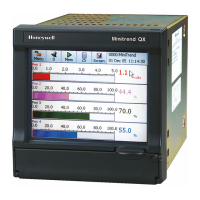78 43-TV-25-30 Iss.6 GLO Aug 07 UK
Refer to the Modbus Master Installation Instructions that are on the CD to help set up
other modbus devices to talk to the recorder. (43-TV-33-89 - 43-TV-33-102).
Master
• Enabled - Toggle On to make this recorder a Master device
• Poll Rate - Enter a time period in seconds of how often there is a request for data
• Legacy Ethernet - Tick this to connect to
Honeywell V5 recorders.
• Slave 1 ..32 - Up to 32 slaves can be setup per master device. Setup each Slave in turn
starting with number 1.
• • Enabled - Toggle On to enable Slave #
• • Friendly name - Enter a name to easily identify this slave device
• • ID - This is to connect to slave ID
• • Port - Select this for a list of available ports, either Ethernet or RS485. For port
configuration see
“Ports” on page 74.
• • Network Name - (Ethernet only). Enter the recorders IP address or the Network
name, eg. xs-nnnnnn, where nnnnnn is the recorder’s 6-digit Serial number. See
“System” on page 156
for the recorder’s IP address and serial number.
• • Protocol - Select this for a list of available protocols. Modbus or Modbus X*.
Modbus and Modbus X can both use Ethernet or RS485 Ports. Protocols define
the format in which the data is transferred from the recorder to a PC or transfer
between other devices and peripherals. FPLB – Floating Point Little Endian
Byte Swapped Format & FP B - Floating Point Big Endian Format are standard
notations.
• • Transaction 1 ..8 - A request for a register or set of contiguous registers
Enabled - Toggle On to enable the first transaction request
Direction - Direction for the data to flow; In to or Out from the recorder
Command - This is the type of Registers used by the slave device. Refer to the
individual memory map for the register type used for each type of device.
Data Type - Refer to individual memory maps for each type of device to deter-
mine the type of data. Eg.
signed 16-bit int, unsigned 16-bit int or IEEE
float.
X Series devices use IEEE float.
Start Addr. - This is the register address number to start the transaction from
No. Of Items - Enter the number of items from the start address that are
included in the transaction. For example displayed here will be
10 SCV[1,1,1] - [1,1,10].
This means the transaction will take 10 items from the start address with a
Serial Comms variable of Slave [1], Transaction [1], Register [1] - to Slave [1],
Transaction [1], Register [10]

